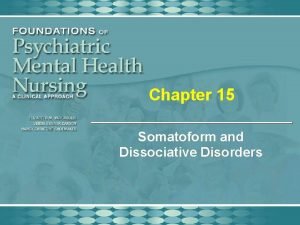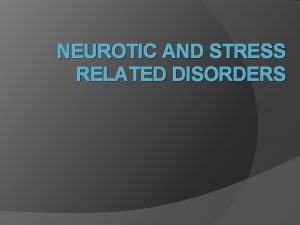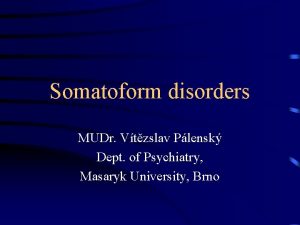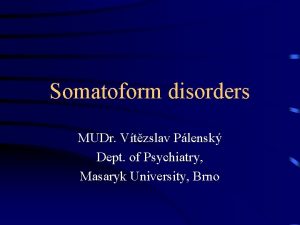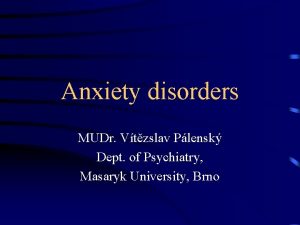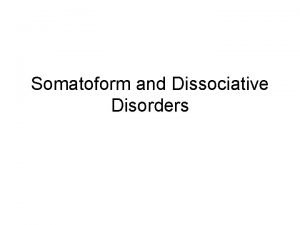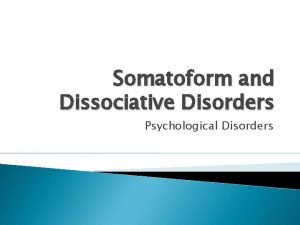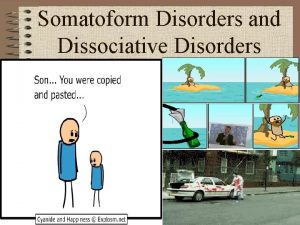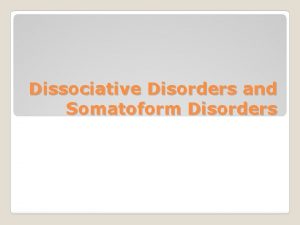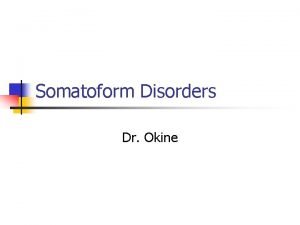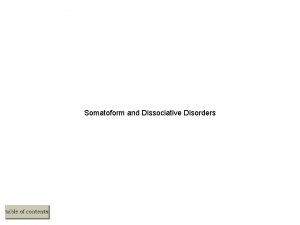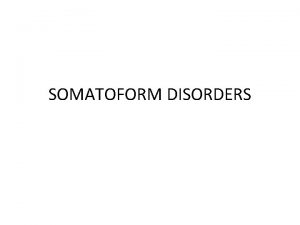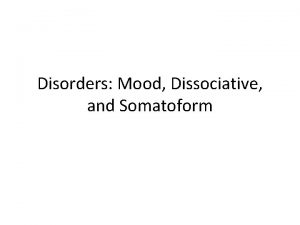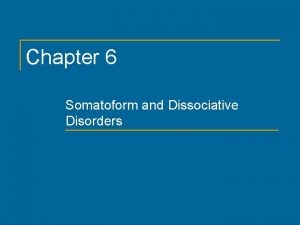Somatoform disorders MUDr Vtzslav Plensk Dept of Psychiatry
















- Slides: 16

Somatoform disorders MUDr. Vítězslav Pálenský Dept. of Psychiatry, Masaryk University, Brno

Somatoform disorders • Assume the form of somatic disorders • Emotional factors predominate in the origin of physical symptoms • Very common in general medical practice

Somatoform disorders • • • 1. Somatization disorder 2. Undifferentiated somatoform disorder 3. Hypochondriasis 4. Body dysmorphic disorder 5. Conversion disorder 6. Pain disorder

Somatization disorder • Multiple recurrent somatic complaints of several years´ duration are not due to any physical disorder

Somatization disorder -diagnostic criteria • A. History of many physical complaints beginning before age 30 yers • B. Each of the following /these cannot be explained by general medidal condition/ – four pain symptoms -two gastrointestinal – one sexual -one pseudoneurological • C. The symptoms are not intentionally produced

Undifferentiated somatoform disorder • One or more somatic complaints of at least 6 months´ duration that do not meet the criteria for somatization disorder

Undifferentiated somatoform disorder - diagnostic criteria • One or more physical complaints lasting at least six month causing distress or impairment • Are not due to general medical condition or a drug substance etc. • The symptom is not intentionally produced and better accounted for by another mental disorder

Hypochondriasis • Unfounded fears of having serious illness

Hypochondriasis - diagnostic criteria • Fears of having a serious desease persisting despite appropriate medical evaluation • The fear is not of delusional intensity • Cause impairment and distress • Duration at least 6 months • Not better accounted for by another mental disorder

Body dysmorphic disorder • Preoccupation with an imagined defect in appearence, which causes significant distress and is not better accounted for by another mental disorder

Conversion disorder • Sudden, dramatic loss of physical functioning that has no known pathophysiological cause and appears to be a manifestation of a psychological need or conflict

Conversion disorder - diagnostic criteria • One or more symptoms suggesting a neurological or other general medical condition, preceded by conflict or other stressor • The symptoms are not intentionally produced and cannot better accounted for by another mental disorder • Causes distress or impairment

Pain disorder • Pain in the absence of adequate physical findings or pathophysiological explanations and in association with psychological factors that seem to play an etiological role

Pain disorder - diagnostic criteria • Pain in one or more anatomical sites causing clinical significant distress • Psychological factors have an important role in the onset • The symptom or deficit is not intentionaly produced • The pain is not better accounted for by a mood, anxiety or psychotic disorder

Somatoform disorders - treatment • Treatment is difficult, patients usually refuse to accept the possibility of psychological fundamentals. Ussualy are used either – pharmacotherapy /antidepressant, antianxiety medications/ – psychotherapy /dynamic, exploration/ • Good working relationship between the psychiatrist and other physicians is required

References: § Waldinger RJ. : Psychiatry for medical students, Washington, DC : American Psychaitric Press, 1997 • Kaplan HI, Sadock BJ, Grebb JA. : Kaplan and Sadock´s synopsis of psychiatry, Baltimore: Williams and Wilkins, 1997
 Somatization disorder
Somatization disorder Neurotic stress-related and somatoform disorders
Neurotic stress-related and somatoform disorders Somatic symptom disorder
Somatic symptom disorder Neurotic stress related and somatoform disorders
Neurotic stress related and somatoform disorders Plensk
Plensk Plensk
Plensk Epidemiologi gangguan somatoform
Epidemiologi gangguan somatoform Somatoform disorder
Somatoform disorder Gangguan somatoform
Gangguan somatoform Hyperventilation treatment
Hyperventilation treatment Core psychiatry
Core psychiatry Cécile hanon
Cécile hanon Gipsofia
Gipsofia Addiction psychiatry expert witness
Addiction psychiatry expert witness Who is this
Who is this National network of child psychiatry access programs
National network of child psychiatry access programs Radical psychiatry sociology
Radical psychiatry sociology
